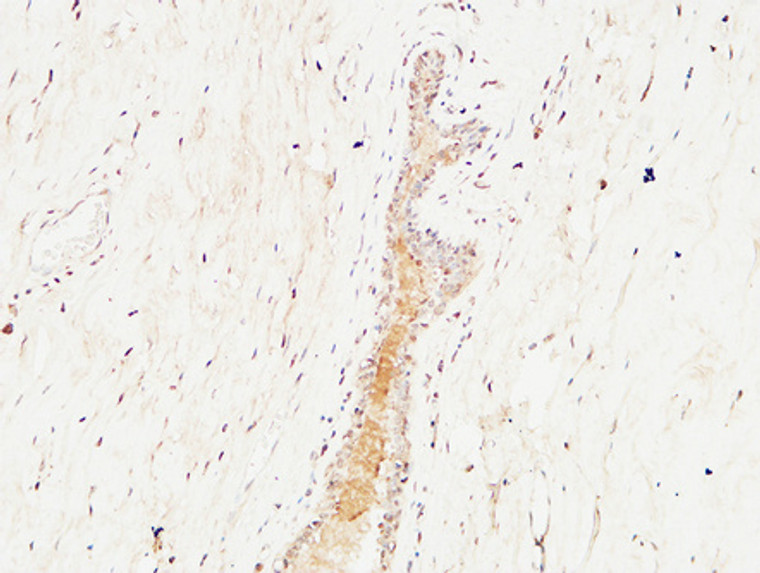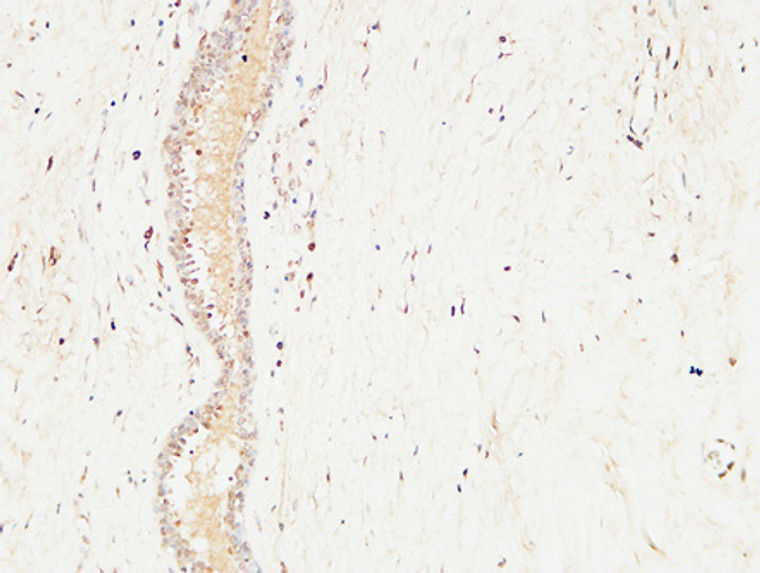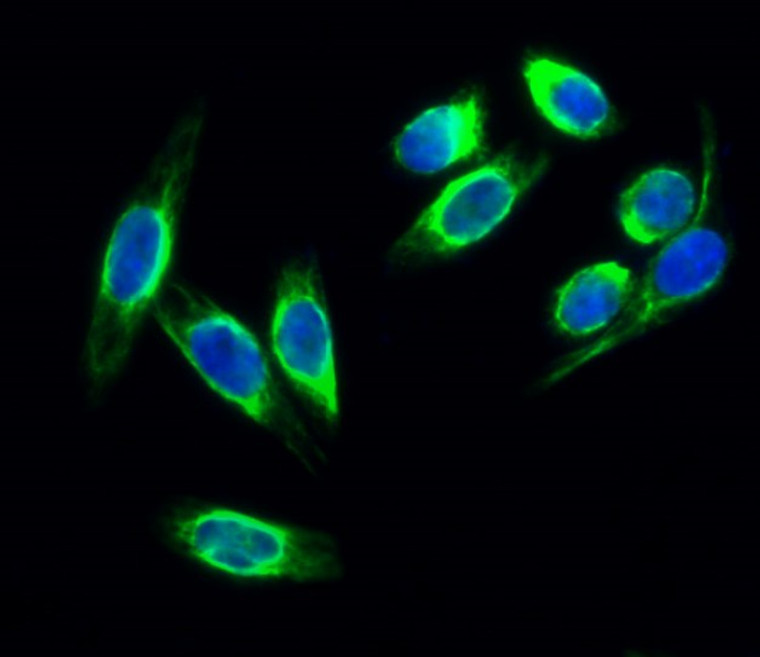| Host: |
Rabbit |
| Applications: |
WB/IHC/IF/ELISA |
| Reactivity: |
Human/Mouse/Rat/Monkey |
| Note: |
STRICTLY FOR FURTHER SCIENTIFIC RESEARCH USE ONLY (RUO). MUST NOT TO BE USED IN DIAGNOSTIC OR THERAPEUTIC APPLICATIONS. |
| Short Description: |
Rabbit polyclonal antibody anti-Mast/stem cell growth factor receptor Kit (688-737 aa) is suitable for use in Western Blot, Immunohistochemistry, Immunofluorescence and ELISA research applications. |
| Clonality: |
Polyclonal |
| Conjugation: |
Unconjugated |
| Isotype: |
IgG |
| Formulation: |
Liquid in PBS containing 50% Glycerol, 0.5% BSA and 0.02% Sodium Azide. |
| Purification: |
The antibody was affinity-purified from rabbit antiserum by affinity-chromatography using epitope-specific immunogen. |
| Concentration: |
1 mg/mL |
| Dilution Range: |
WB 1:500-1:2000IHC-P 1:100-300ELISA 1:20000IF 1:100-300 |
| Storage Instruction: |
Store at-20°C for up to 1 year from the date of receipt, and avoid repeat freeze-thaw cycles. |
| Gene Symbol: |
KIT |
| Gene ID: |
3815 |
| Uniprot ID: |
KIT_HUMAN |
| Immunogen Region: |
688-737 aa |
| Specificity: |
c-Kit Polyclonal Antibody detects endogenous levels of c-Kit protein. |
| Immunogen: |
The antiserum was produced against synthesized peptide derived from the human c-Kit at the amino acid range 688-737 |
| Post Translational Modifications | Ubiquitinated by SOCS6. KIT is rapidly ubiquitinated after autophosphorylation induced by KITLG/SCF binding, leading to internalization and degradation. Autophosphorylated on tyrosine residues. KITLG/SCF binding enhances autophosphorylation. Isoform 1 shows low levels of tyrosine phosphorylation in the absence of added KITLG/SCF (in vitro). Kinase activity is down-regulated by phosphorylation on serine residues by protein kinase C family members. Phosphorylation at Tyr-568 is required for interaction with PTPN11/SHP-2, CRK (isoform Crk-II) and members of the SRC tyrosine-protein kinase family. Phosphorylation at Tyr-570 is required for interaction with PTPN6/SHP-1. Phosphorylation at Tyr-703, Tyr-823 and Tyr-936 is important for interaction with GRB2. Phosphorylation at Tyr-721 is important for interaction with PIK3R1. Phosphorylation at Tyr-823 and Tyr-936 is important for interaction with GRB7. |
| Function | Tyrosine-protein kinase that acts as a cell-surface receptor for the cytokine KITLG/SCF and plays an essential role in the regulation of cell survival and proliferation, hematopoiesis, stem cell maintenance, gametogenesis, mast cell development, migration and function, and in melanogenesis. In response to KITLG/SCF binding, KIT can activate several signaling pathways. Phosphorylates PIK3R1, PLCG1, SH2B2/APS and CBL. Activates the AKT1 signaling pathway by phosphorylation of PIK3R1, the regulatory subunit of phosphatidylinositol 3-kinase. Activated KIT also transmits signals via GRB2 and activation of RAS, RAF1 and the MAP kinases MAPK1/ERK2 and/or MAPK3/ERK1. Promotes activation of STAT family members STAT1, STAT3, STAT5A and STAT5B. Activation of PLCG1 leads to the production of the cellular signaling molecules diacylglycerol and inositol 1,4,5-trisphosphate. KIT signaling is modulated by protein phosphatases, and by rapid internalization and degradation of the receptor. Activated KIT promotes phosphorylation of the protein phosphatases PTPN6/SHP-1 and PTPRU, and of the transcription factors STAT1, STAT3, STAT5A and STAT5B. Promotes phosphorylation of PIK3R1, CBL, CRK (isoform Crk-II), LYN, MAPK1/ERK2 and/or MAPK3/ERK1, PLCG1, SRC and SHC1. |
| Protein Name | Mast/Stem Cell Growth Factor Receptor KitScfrPiebald Trait ProteinPbtProto-Oncogene C-KitTyrosine-Protein Kinase KitP145 C-KitV-Kit Hardy-Zuckerman 4 Feline Sarcoma Viral Oncogene HomologCd Antigen Cd117 |
| Database Links | Reactome: R-HSA-1257604Reactome: R-HSA-1433557Reactome: R-HSA-1433559Reactome: R-HSA-2219530Reactome: R-HSA-5673001Reactome: R-HSA-6811558Reactome: R-HSA-8866910Reactome: R-HSA-9669914Reactome: R-HSA-9669917Reactome: R-HSA-9669921Reactome: R-HSA-9669924Reactome: R-HSA-9669926Reactome: R-HSA-9669929Reactome: R-HSA-9669933Reactome: R-HSA-9669934Reactome: R-HSA-9669935Reactome: R-HSA-9669936Reactome: R-HSA-9670439Reactome: R-HSA-9680187Reactome: R-HSA-9856649 |
| Cellular Localisation | Isoform 1: Cell MembraneSingle-Pass Type I Membrane ProteinIsoform 2: Cell MembraneIsoform 3: CytoplasmDetected In The Cytoplasm Of SpermatozoaEspecially In The Equatorial And Subacrosomal Region Of The Sperm Head |
| Alternative Antibody Names | Anti-Mast/Stem Cell Growth Factor Receptor Kit antibodyAnti-Scfr antibodyAnti-Piebald Trait Protein antibodyAnti-Pbt antibodyAnti-Proto-Oncogene C-Kit antibodyAnti-Tyrosine-Protein Kinase Kit antibodyAnti-P145 C-Kit antibodyAnti-V-Kit Hardy-Zuckerman 4 Feline Sarcoma Viral Oncogene Homolog antibodyAnti-Cd Antigen Cd117 antibodyAnti-KIT antibodyAnti-SCFR antibody |
Information sourced from Uniprot.org
12 months for antibodies. 6 months for ELISA Kits. Please see website T&Cs for further guidance











